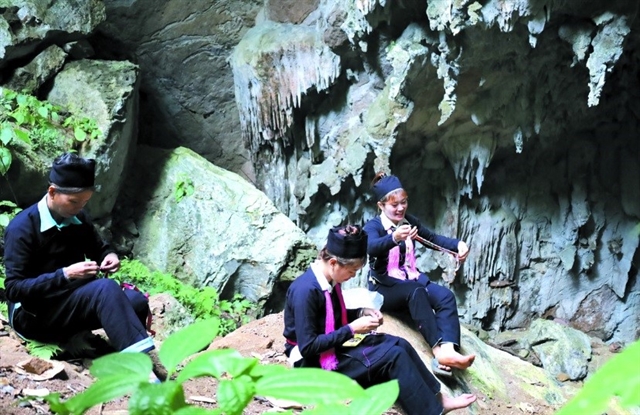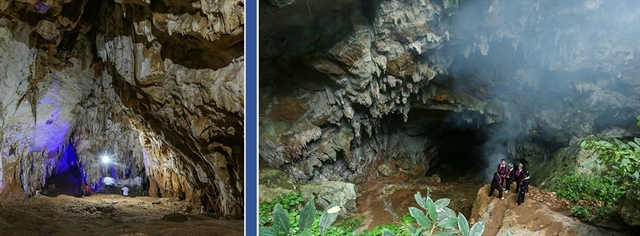
Tiên Cảnh Cave is closely associated with the life of the Dao people in the village. — Photo baolaocai.vn
Lâm Giang
Located among the rolling mountains of Bảo Yên District, Tiên Cảnh Cave is a jewel of Lào Cai Province.
The cave has a total length of 158m, like a castle with the beauty of a fairyland with many stalactites, and colourful columns layered to create a unified whole.
Along the way to Tiên Cảnh, we saw beautiful countryside all the time. There are rice fields, maize fields and winding streams right at the foot of the mountain. Looking into the distance, the mountainous countryside appears peaceful.
From Thâu 1 Village, we followed a small, rocky road for 300m. We left the motorbikes behind to walk through the newly opened road which was still fragrant with the smell of earth to reach the cave. The road leads to the edge of the forest, then through more than 100m of bamboo forest to the entrance of the cave.
In front of the cave, there is a large banyan tree with long roots in the deep green mountains. Under the banyan canopy are indigo bushes with purple flowers.
The entrance of Tiên Cảnh has the form of a natural sinkhole covered by a wide, solid stone roof. The roof of the cave has many shapes that nature creates such as beetles, dinosaur teeth, and dense sharp swords.
In this area, the stalactites connect one after another from the arch to the bottom like endless hair.
On the left side of the cave, the stalactites are very bright, hanging down like a curtain, where the thick roots of the trees are interwoven with the smooth stalactite like a vivid lacquer painting. In general, the roof of the cave is like a dragon's jaw opening wide, yawning after centuries of sleeping peacefully in majestic nature.

A corner of Tiên Cảnh Cave. — Photo laocai.gov.vn
After 400 steps, we were immersed in a 'fairytale landscape' with the appearance of countless colourful stalactites. The temperature was very cool, suitable for the experience on hot summer days.
The cave has three areas that converge distinct features, forming an attraction for tourists who love adventure.
Stepping through the cave door, we came to the Sơn Trang area. This area’s floor slopes gently with the stone veins like the terraced fields of the high mountains. This is the area with the most stalactites, forming a majestic mountain forest.
Sitting on the largest rock that is naturally arranged in the middle of the area, we enjoyed the panoramic view of stalactites like a magnificent European castle. There are many stalactites like giant crystal blocks, emitting a magical light every time a ray of light shines on. This is the first stop to see the most magnificent things of Sơn Trang.
Standing at each different position, each of us was immersed in our own emotions, but one thing that couldn’t be denied was to see the beauty of this landscape.
The next area is narrowed, the path is small with many stalactites growing from the ground. It likes a coral reef, making people feel like they are under the vast ocean, so the locals named it Thủy Cung (Water-God's Palace).
On the coral reefs, stalactites are cleverly shaped into the image of a mother holding her child in front of her chest. At the bottom, there are three stone columns connecting to the top of the cave like a gate.

Visitors in Tiên Cảnh Cave. — Photo baolaocai.vn
At the bottom of the cave is a wide, flat base, where stalactites hang from the ceiling. The cave wall is a solid rock layer covered with dark brown powdery soil. It is that soil that smoothers the sound of the cave. In this area, stalactites rise from the floor forming a table, with three stalactites floating around like people enjoying tea.
According to Phan Chí Cường, head of the Research and Collection Department of Lào Cai Provincial Museum, besides the aesthetic beauty bestowed by nature, Tiên Cảnh Cave is also valuable in terms of history, scientific research, very suitable for tourism development.
“The attraction here not only comes from the wide cave, diverse and rich stalactite system, beautiful ecological environment but at the cave’s is also the living place of the Dao ethnic group, with unique cultures and traditions of growing cotton and weaving.
"If the cave is properly invested, it will surely become an attractive and interesting experience place for visitors on the journey to discover the province,” Cường said. VNS

The road to Tiên Cảnh Village. — Photo baolaocai.vn
OVietnam